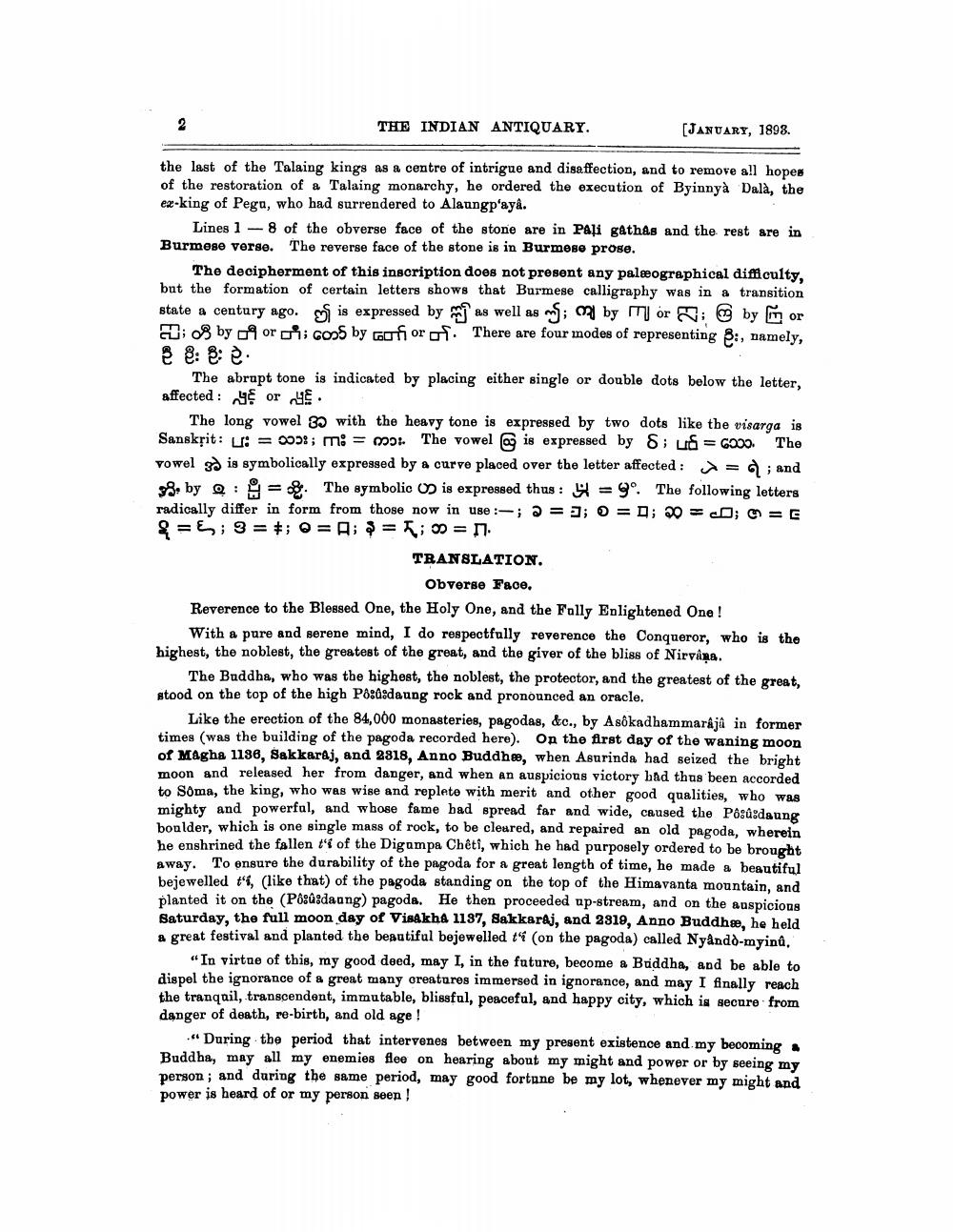Book Title: Indian Antiquary Vol 22 Author(s): Richard Carnac Temple Publisher: Swati Publications View full book textPage 6
________________ THE INDIAN ANTIQUARY. [JANUARY, 1898. the last of the Talaing kings as a centre of intrigue and disaffection, and to remove a!l hopes of the restoration of a Talaing monarchy, he ordered the execution of Byinnyà Dalà, the ex-king of Pego, who had surrendered to Alaungp'aya. Lines 1 - 8 of the obverse face of the stone are in PAli gathas and the rest are in Burmese verse. The reverse face of the stone is in Burmese prose. Tho decipherment of this inscription does not present any paleographical difficulty, but the formation of certain letters shows that Burmese calligraphy was in a transition state a century ago. is expressed by mjl as well as my; by m or by or His by on or o Goo by cofior of. There are four modes of representing :, namely, 8: & è. The abrupt tone is indicated by placing either single or double dots below the letter, affected : y or 48. The long vowel 30 with the heavy tone is expressed by two dots like the visarga is Sanskrit: u: = 505!; mi = 2: The vowel is expressed by S; US = 6000. The vowel 80 is symbolically expressed by a curve placed over the letter affected : = a; and by Q: H = The symbolic O is expressed thus : = go. The following letters radically differ in form from those now in use :-; 2 = a; O = 0; 2 = 0; M = G =g; 3= #; @= 0; $ = ñ; = . TRANSLATION. Obverse Face, Reverence to the Blessed One, the Holy One, and the Folly Enlightened One! With a pure and serene mind, I do respectfully reverence the Conqueror, who is the highest, the noblest, the greatest of the great, and the giver of the bliss of Nirvana. The Buddha, who was the highest, the noblest, the protector, and the greatest of the great, stood on the top of the high Po:dedaung rock and pronounced an oracle. Like the erection of the 84,000 monasteries, pagodas, &c., by Asökadhammarája in former times (was the building of the pagoda recorded here). On the first day of the waning moon of Magha 1136, Sakkaraj, and 2818, Anno Buddhe, when Aburinda had seized the bright moon and released her from danger, and when an auspicious victory bad thus been accorded to Soma, the king, who was wise and replete with merit and other good qualities, who was mighty and powerful, and whose fame had spread far and wide, caused the Posû:daung bonlder, which is one single mass of rock, to be cleared, and repaired an old pagoda, wherein he enshrined the fallen t'i of the Digumpa Chêti, which he had purposely ordered to be brought away. To ensure the durability of the pagoda for a great length of time, he made a beautiful bejewelled t'i, (like that) of the pagoda standing on the top of the Himavanta mountain, and planted it on the (Pôsû:daong) pagoda. He then proceeded up-stream, and on the auspicions Saturday, the full moon day of Visakha 1137, Sakkaraj, and 2919, Anno Buddha, he held a great festival and planted the beautiful bejewelled " (on the pagoda) called Nyåndd-myinů. "In virtue of this, my good deed, may I, in the future, become a Buddha, and be able to dispel the ignorance of a great many creatures immersed in ignorance, and may I finally reach the tranquil, transcendent, immutable, blissful, peaceful, and happy city, which is secure from danger of death, re-birth, and old age ! ." During the period that intervenes between my present existence and my becoming Buddha, may all my enemies flee on hearing about my might and power or by seeing my person; and during the same period, may good fortune be my lot, whenever my might and power is heard of or my person seen!Page Navigation
1 ... 4 5 6 7 8 9 10 11 12 13 14 15 16 17 18 19 20 21 22 23 24 25 26 27 28 29 30 31 32 33 34 35 36 37 38 39 40 41 42 43 44 45 46 47 48 49 50 51 52 53 54 55 56 57 58 59 60 61 62 ... 442
